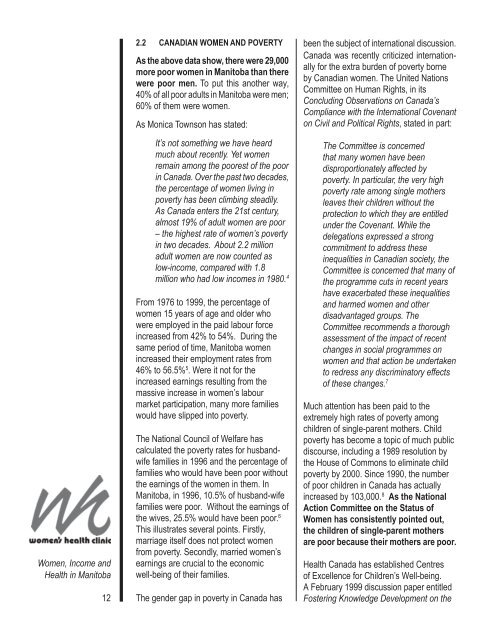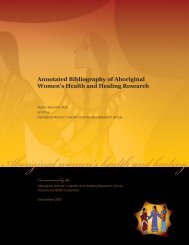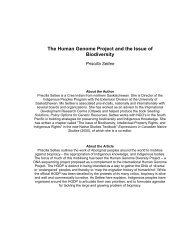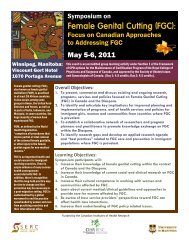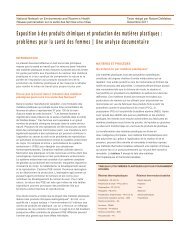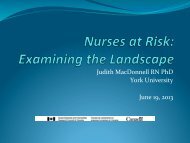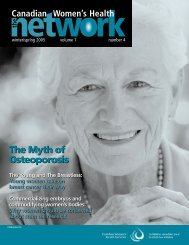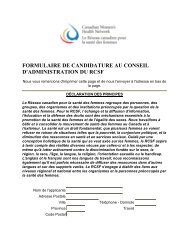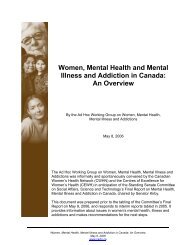Women, Income and<strong>Health</strong> in Manitoba122.2 CANADIAN WOMEN AND POVERTYAs the above data show, t<strong>here</strong> were 29,000more poor women in Manitoba than t<strong>here</strong>were poor men. To put this another way,40% of all poor adults in Manitoba were men;60% of them were women.As Monica Townson has stated:It’s not something we have heardmuch about recently. Yet womenremain among the poorest of the poorin Canada. Over the past two decades,the percentage of women living inpoverty has been climbing steadily.As Canada enters the 21st century,almost 19% of adult women are poor– the highest rate of women’s povertyin two decades. About 2.2 millionadult women are now counted aslow-income, compared with 1.8million who had low incomes in 1980. 4From 1976 to 1999, the percentage ofwomen 15 years of age and older whowere employed in the paid labour forceincreased from 42% to 54%. During thesame period of time, Manitoba womenincreased their employment rates from46% to 56.5% 5 . Were it not for theincreased earnings resulting from themassive increase in women’s labourmarket participation, many more familieswould have slipped into poverty.The National Council of Welfare hascalculated the poverty rates for husbandwifefamilies in 1996 and the percentage offamilies who would have been poor withoutthe earnings of the women in them. InManitoba, in 1996, 10.5% of husband-wifefamilies were poor. Without the earnings ofthe wives, 25.5% would have been poor. 6This illustrates several points. Firstly,marriage itself does not protect womenfrom poverty. Secondly, married women’searnings are crucial to the economicwell-being of their families.The gender gap in poverty in Canada hasbeen the subject of international discussion.Canada was recently criticized internationallyfor the extra burden of poverty borneby <strong>Canadian</strong> women. The United NationsCommittee on Human Rights, in itsConcluding Observations on Canada’sCompliance with the International Covenanton Civil and Political Rights, stated in part:The Committee is concernedthat many women have beendisproportionately affected bypoverty. In particular, the very highpoverty rate among single mothersleaves their children without theprotection to which they are entitledunder the Covenant. While thedelegations expressed a strongcommitment to address theseinequalities in <strong>Canadian</strong> society, theCommittee is concerned that many ofthe programme cuts in recent yearshave exacerbated these inequalitiesand harmed women and otherdisadvantaged groups. TheCommittee recommends a thoroughassessment of the impact of recentchanges in social programmes onwomen and that action be undertakento redress any discriminatory effectsof these changes. 7Much attention has been paid to theextremely high rates of poverty amongchildren of single-parent mothers. Childpoverty has become a topic of much publicdiscourse, including a 1989 resolution bythe House of Commons to eliminate childpoverty by 2000. Since 1990, the numberof poor children in Canada has actuallyincreased by 103,000. 8 As the NationalAction Committee on the Status ofWomen has consistently pointed out,the children of single-parent mothersare poor because their mothers are poor.<strong>Health</strong> Canada has established Centresof Excellence for Children’s Well-being.A February 1999 discussion paper entitledFostering Knowledge Development on the
<strong>Health</strong> and Well-Being of Children inCanada recognized that “while not allchildren who are poor experience negativehealth outcomes, t<strong>here</strong> is a great deal ofevidence showing a major link betweenfamily income and many measures ofhealth and well-being.” 9Less attention has been paid to the plightof unattached senior women – that is,those women 65 years of age or older whoare either single, separated, divorced orwidowed. In 1999, over 51% of thesesenior unattached women in Manitobawere poor. This number has not changedin the thirty years since the publication ofthe Report of the Royal Commission on theStatus of Women. 10Women with disabilities are also at higherrisk of poverty than either womenwithout disabilities or men withdisabilities. In 1996, 27% of womenwith disabilities aged 16 to 64 lived inpoverty. Almost two-thirds of those livedmore than 25% below the poverty line. 11As Gail Fawcett has noted, “men with disabilitiesface many of the same barriers aswomen; however, for women, the barriers areoften more pronounced and the negativeoutcomes more severe.” 12Other groups of women at higher riskfor poverty include Aboriginal women(see below 2.3), visible minority women (seebelow 2.4), and women who are separatedand divorced.2.3 ABORIGINAL WOMEN & POVERTYIn 1996, Manitoba, with approximately5% of the total population of Canada,was home to 16.1% of the country’s totalAboriginal population, 64,665 women and62,900 men. 13 Looking at this another way,in 1996, 11.7% of Manitoba’s population wereAboriginal people.The term “Aboriginal” includes First Nations,Métis and Inuit people. This terminology,while useful, does not allow exploration andanalysis of the very real differences withinand among these groups. The lives of FirstNations peoples, for example, are affectedby their status under the Indian Act. FirstNations people may be classified as“Status” or “Non-Status” Indians, “RegisteredIndians On Reserve” or “Registered IndiansOff Reserve”, “Treaty” or “Non-Treaty” or “BillC-31 Members”. For the purposes of thispaper, the term “Aboriginal” will be used torefer to all of the original people of Canada.It should also be noted that while 1996Census of Canada data is used below, someFirst Nations communities chose not toparticipate in the 1996 Census of Canada.What impact, if any, their participation mighthave had on this data is not known.TABLE 3ABORIGINAL AND NON-ABORIGINAL POVERTY RATES, 1995Women, Income and<strong>Health</strong> in Manitoba13POVERTY RATESPERSONS 15 YEARS AND OVERMale Female Gender GapAboriginal People 35.1% 42.7% 21.60%Non-Aboriginal People 16.4% 20.3% 23.8%SOURCE: Women in Canada 2000, Table 11.14
- Page 1 and 2: WOMEN, INCOME ANDHEALTH IN MANITOBA
- Page 3 and 4: TABLE OF CONTENTSPageA. EXECUTIVE S
- Page 5 and 6: EXECUTIVE SUMMARYTHE LINK between p
- Page 7 and 8: Women, Income andHealth in Manitoba
- Page 9 and 10: B. INTRODUCTIONMuch work has been d
- Page 11: Consistent with the majority of soc
- Page 15 and 16: Women, Income andHealth in Manitoba
- Page 17 and 18: members of different visible minori
- Page 19 and 20: Women, Income andHealth in Manitoba
- Page 21 and 22: 3. How has the connection between i
- Page 23 and 24: E. INCOME AND THE HEALTH OF WOMEN -
- Page 25 and 26: Women, Income andHealth in Manitoba
- Page 27 and 28: majority of British households,rega
- Page 29 and 30: Women, Income andHealth in Manitoba
- Page 31 and 32: The following chart, based on a cha
- Page 33 and 34: marsh potatoes, berries, etc. As a
- Page 35 and 36: opportunities for women may beone o
- Page 37 and 38: 2. Manitoba Data - Income and Healt
- Page 39 and 40: CHART 3HEALTH CARE EXPENDITURES ON
- Page 41 and 42: 3. What Does This Mean?As in other
- Page 43 and 44: procedures. It is noteworthy that t
- Page 45 and 46: 2. The Commonwealth Secretariat -Mo
- Page 47 and 48: Women, Income andHealth in Manitoba
- Page 49 and 50: H. MAKING PUBLIC POLICY HEALTHIER F
- Page 51 and 52: against women and its consequences
- Page 53 and 54: 3.3 CHILD TAX BENEFITThe Government
- Page 55 and 56: Household Basic Rent Rent Including
- Page 57 and 58: If RHAs are open to suchcollaborati
- Page 59 and 60: APPENDIX 1:SUGGESTIONS FOR FUTURE R
- Page 61 and 62: Women, Income andHealth in Manitoba
- Page 63 and 64:
APPENDIX 3:HEALTH SERVICE UTILIZATI
- Page 65 and 66:
APPENDIX 4:INTERVIEWS WITH ABORIGIN
- Page 67 and 68:
Women, Income andHealth in Manitoba
- Page 69 and 70:
Women, Income andHealth in Manitoba
- Page 71 and 72:
Women, Income andHealth in Manitoba
- Page 73 and 74:
ELEMENT #11GENDER SENSITIVE TRAININ
- Page 75 and 76:
Women, Income andHealth in Manitoba
- Page 77 and 78:
ENDNOTES1. Sarlo, Christopher, “P
- Page 79 and 80:
ENDNOTES (continued)45. Arber, Sara
- Page 81 and 82:
ENDNOTES (continued)88. Mustard, Ca
- Page 83 and 84:
REFERENCES (continued)Clarke, H.F.
- Page 85 and 86:
REFERENCES (continued)Macintyre, Sa
- Page 87 and 88:
REFERENCES (continued)Vancouver/Ric


